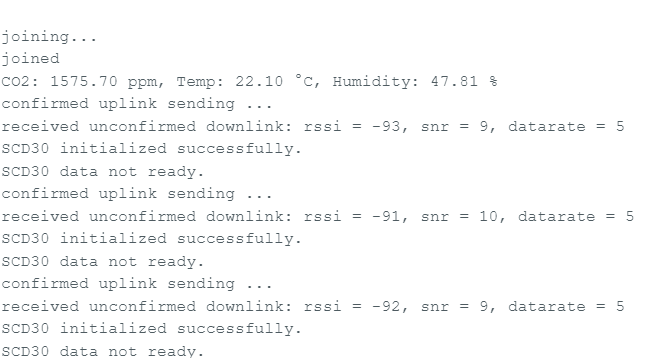Hi everyone, I am creating the weather station project based on Heltec Wifi Lora 32(version3.1) with SCD40 temperature,humidity and CO2 sensor. After uploading my code and connecting it to the TTN, it only sends uplink once. After that, it only receives downlink and can not send the uplink again.
Here is code:
#include “LoRaWan_APP.h”
#include <Wire.h>
#include “Adafruit_SCD30.h”
// SCD30 instance
Adafruit_SCD30 scd30;
/* OTAA parameters (your end device credentials) */
uint8_t devEui[] = { *****************};
uint8_t appEui[] = { **************************** };
uint8_t appKey[] = { ************************************* };
/* ABP parameters (not used in OTAA mode, but kept for reference) */
uint8_t nwkSKey[] = { 0x15, 0xB1, 0xD0, 0xEF, 0xA4, 0x63, 0xDF, 0xBE, 0x3D, 0x11, 0x18, 0x1E, 0x1E, 0xC7, 0xDA, 0x85 };
uint8_t appSKey[] = { 0xD7, 0x2C, 0x78, 0x75, 0x8C, 0xDC, 0xCA, 0xBF, 0x55, 0xEE, 0x4A, 0x77, 0x8D, 0x16, 0xEF, 0x67 };
uint32_t devAddr = (uint32_t)0x007E6AE1;
/* LoRaWAN channel mask */
uint16_t userChannelsMask[6] = { 0x00FF, 0x0000, 0x0000, 0x0000, 0x0000, 0x0000 };
/* LoRaWAN region, select in Arduino IDE tools */
LoRaMacRegion_t loraWanRegion = ACTIVE_REGION;
/* LoRaWAN class, Class A and Class C are supported */
DeviceClass_t loraWanClass = CLASS_A;
/* Application data transmission duty cycle (value in ms) */
uint32_t appTxDutyCycle = 15000;
/* OTAA activation */
bool overTheAirActivation = true;
/* Adaptive data rate (ADR) enable */
bool loraWanAdr = true;
/* Indicates if the node is sending confirmed or unconfirmed messages */
bool isTxConfirmed = true;
/* Application port */
uint8_t appPort = 2;
/* Number of trials to transmit the frame */
uint8_t confirmedNbTrials = 4;
/* Prepares the payload of the frame */
static void prepareTxFrame(uint8_t port)
{
if (scd30.dataReady())
{
if (!scd30.read())
{
Serial.println("Failed to read data from SCD30!");
return;
}
// Convert float values to integers for transmission
uint16_t co2_int = (uint16_t)scd30.CO2; // CO2 in ppm
uint16_t temp_int = (uint16_t)(scd30.temperature * 10); // Temp in 0.1°C
uint16_t hum_int = (uint16_t)(scd30.relative_humidity * 10); // Humidity in 0.1%
// Prepare LoRaWAN payload
appDataSize = 6;
appData[0] = (co2_int >> 8) & 0xFF;
appData[1] = co2_int & 0xFF;
appData[2] = (temp_int >> 8) & 0xFF;
appData[3] = temp_int & 0xFF;
appData[4] = (hum_int >> 8) & 0xFF;
appData[5] = hum_int & 0xFF;
Serial.print("CO2: ");
Serial.print(scd30.CO2);
Serial.print(" ppm, Temp: ");
Serial.print(scd30.temperature);
Serial.print(" °C, Humidity: ");
Serial.print(scd30.relative_humidity);
Serial.println(" %");
}
else
{
Serial.println("SCD30 data not ready.");
}
}
void setup() {
Serial.begin(115200);
// Initialize I2C for SCD30
Wire.begin(41, 42); // SDA = 41, SCL = 42
// Initialize the SCD30 sensor
if (!scd30.begin())
{
Serial.println("Failed to initialize SCD30! Check wiring.");
while (1);
}
Serial.println("SCD30 initialized successfully.");
// LoRaWAN initialization
Mcu.begin(HELTEC_BOARD, SLOW_CLK_TPYE);
}
void loop()
{
switch (deviceState)
{
case DEVICE_STATE_INIT:
{
#if (LORAWAN_DEVEUI_AUTO)
LoRaWAN.generateDeveuiByChipID();
#endif
LoRaWAN.init(loraWanClass, loraWanRegion);
LoRaWAN.setDefaultDR(3);
break;
}
case DEVICE_STATE_JOIN:
{
LoRaWAN.join();
break;
}
case DEVICE_STATE_SEND:
{
prepareTxFrame(appPort);
LoRaWAN.send();
deviceState = DEVICE_STATE_CYCLE;
break;
}
case DEVICE_STATE_CYCLE:
{
txDutyCycleTime = appTxDutyCycle + randr(-APP_TX_DUTYCYCLE_RND, APP_TX_DUTYCYCLE_RND);
LoRaWAN.cycle(txDutyCycleTime);
deviceState = DEVICE_STATE_SLEEP;
break;
}
case DEVICE_STATE_SLEEP:
{
LoRaWAN.sleep(loraWanClass);
break;
}
default:
{
deviceState = DEVICE_STATE_INIT;
break;
}
}
}
And this is the output from serial monitor in Arduino IDE: 


